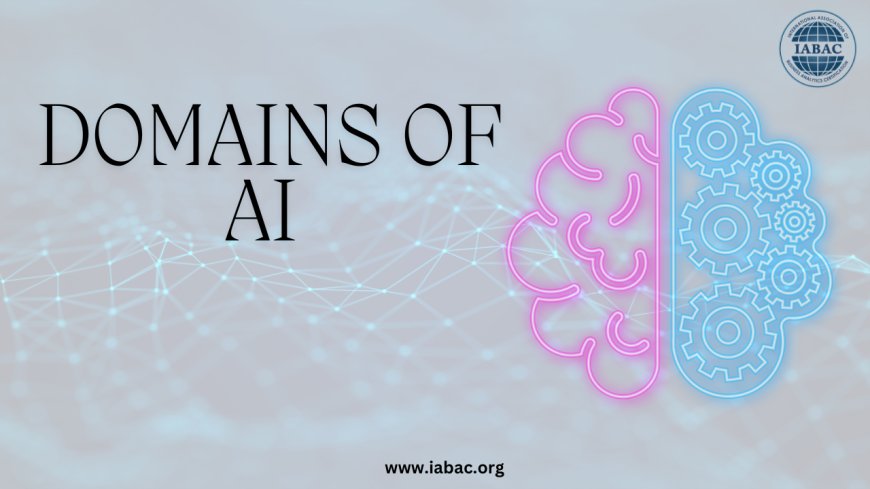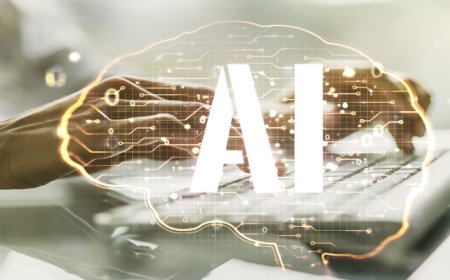Understanding the Various Domains of AI
Explore the diverse realms of AI, from machine learning to natural language processing. Understand AI's vast applications and implications.

Artificial intelligence (AI) has maintained itself smoothly in our daily lives, exerting a subtle yet significant influence across many kinds of fields. Artificial intelligence (AI) algorithms function in various sectors, influencing our lives in ways we might not completely comprehend, from the predictive text on our smartphones to the personalized recommendations provided when shopping online. Through the analysis of medical pictures, AI's domain in healthcare helps physicians diagnose patients more precisely. In the transportation sector, AI powers the development of self-driving cars and optimizes routes for ride-sharing applications, revolutionizing mobility.
Above these well-known domains, the many fields of artificial intelligence hold even more revolutionary possibilities for the future. Each domain offers distinct chances for innovation and advancement, ranging from the possibility of AI-driven environmental initiatives to tailored enjoyment recommendations. The impact of artificial intelligence (AI) in its many areas subtly alters our reality, leading us through our daily routines with algorithmic accuracy, even in the face of dramatic superlatives.
Challenges in Interpreting and Explainability of AI Models
-
Complexity of Models:
-
Many AI models are complicated and have millions of parameters, especially those employed in different AI domains like deep learning.
-
The complex internal workings of these models make it difficult to understand how they come to a given conclusion or forecast.
-
Black Box Nature:
-
Certain AI models are referred to as "black boxes" since they make decisions without offering justifications for the choices they make.
-
This lack of transparency can be problematic, particularly in crucial applications where decision-making processes must be understood and trusted, such as in the financial and healthcare domains.
-
Bias and Fairness:
-
Biases from the data used to train AI models can be passed on by the models themselves, producing unfair or discriminatory results in many kinds of AI applications.
-
To maintain justice and equity in decision-making processes, it is important to identify and tackle biases in AI algorithms.
-
Interpretability Techniques:
-
Researchers are creating methods to improve the understanding of AI models in multiple fields of AI domains.
-
Feature importance analysis, model visualization, and producing human-readable explanations for model predictions are some of these methods.
-
Trade-offs:
-
Within several AI domains, there may be trade-offs between interpretability and model performance.
-
While very accurate models may not be interpretable, some highly interpretable models may sacrifice performance.
-
Regulatory Compliance:
-
Regulatory agencies are calling for more justifications for AI-driven choices increasingly more, particularly in AI-sensitive industries like banking and healthcare.
-
For businesses using AI systems, maintaining model performance while following rules presents a big hurdle.
-
User Understanding and Trust:
-
If users are unaware of how AI systems operate or the reasoning behind their judgments, they may be reluctant to trust them, regardless of whether they are experts or consumers.
-
By giving users a greater understanding and sense of trust in the technology, explanations for AI model predictions may improve development and acceptance.
How Do Different Domains of AI Differ and Intersect?
-
Machine Learning:
Machine learning is fundamental in the field of artificial intelligence. It entails teaching algorithms—which are not explicitly programmed—to identify patterns in data and forecast future outcomes. Numerous applications, including fraud detection in financial transactions and tailored recommendations on streaming platforms, are powered by this domain.
-
Deep Learning (DL):
Deep learning (DL), a subset of machine learning (ML) inspired by the brain's structure, utilizes neural networks to analyze large datasets. It excels in domains of AI like image and speech recognition, natural language processing (NLP), and autonomous driving, leveraging its ability to uncover intricate patterns for accurate predictions and decision-making.
-
Natural Language Processing (NLP):
Natural language processing is an additional important field. In this section artificial intelligence (AI) technology allows computers to comprehend, translate, and produce human language. Natural language processing (NLP) is a key component in enabling human-computer interaction, from chatbots and virtual assistants like Siri that offer customer care to language translation services.
-
Computer Vision:
Computer vision is one of the AI professions that focuses on giving robots the capacity to understand and decode visual data from the outside world. This includes interpreting scenes, classifying images, and recognizing objects. Applications extend from surveillance systems spotting security risks to self-driving cars managing metropolitan streets.
-
Robotics:
AI and mechanical engineering are combined in robotics to develop intelligent devices that can complete tasks possibly on their own or with the aid of humans. Robotics is one of the AI fields with many applications, such as industrial automation, healthcare support, and hazardous environment investigation.
-
Expert Systems:
Expert systems are a branch of artificial intelligence (AI) where computers simulate human experts' decision-making processes in particular fields. These systems address complicated issues by applying knowledge bases and rule-based reasoning. Expert systems are used in this sector in industries like finance to make investment decisions and medicine to identify problems.
Uses of Domains of AI
-
Healthcare: Through the analysis of medical imaging such as MRIs and X-rays, AI helps physicians diagnose diseases more rapidly and reliably. Evaluating patient data and forecasting results also helps in individualized treatment programs.
-
Finance: Artificial Intelligence (AI) analyzes credit risk for loan applications, forecasts stock market movements, and finds fraudulent activity in financial transactions. Additionally, it uses virtual assistants and chatbots to automate customer care.
-
Autonomous Vehicles: Self-driving cars using artificial intelligence (AI) can use sensors to sense their environment and make judgments to navigate safely without assistance from a human. This technology could transform transportation and lower the number of accidents.
-
Computer Vision: Applications such as identifying objects for self-driving cars, facial recognition for security systems, and medical image analysis for scan abnormality detection are made possible by artificial intelligence in computer vision.
-
Online shopping: Artificial intelligence (AI)--powered recommendation systems examine user behavior and preferences to make personalized product recommendations that boost sales and improve customer satisfaction.
-
Energy: AI optimizes energy use in industries and buildings by evaluating sensor data and making necessary system adjustments. Additionally, it helps in forecasting energy use and power grid optimization for effective delivery.
-
Education: AI customizes learning by adjusting course material and pace to meet the needs of each unique student. Additionally, it frees up educators' time to concentrate more on teaching by automating administrative tasks.
-
Cybersecurity: By examining network traffic patterns and spotting unusual activity, artificial intelligence (AI) quickly and accurately detects and neutralizes cyber threats. To prevent data breaches, it also aids in vulnerability evaluation and patch management.
Artificial intelligence (AI) is a multidisciplinary field that is transforming several sectors, including healthcare, banking, transportation, and more, as well as our everyday life. Even though AI has many advantages, issues including model complexity, interpretability, bias, and regulatory compliance must be resolved to ensure its ethical and responsible application. We can use AI to drive innovation to improve human well-being while maintaining trust and transparency in its use by comprehending its various domains and using its capabilities in fields like financial analysis, autonomous vehicles, healthcare diagnosis, and personalized recommendations.











































